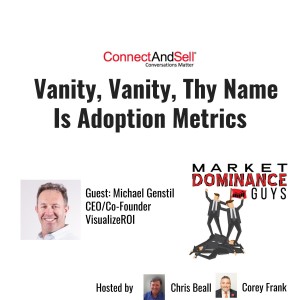Market Dominance Guys
Guest: Michael Genstil
Episodes

Wednesday Nov 25, 2020
EP58: Your Prospect Adores You! But Will His CFO?
Wednesday Nov 25, 2020
Wednesday Nov 25, 2020
Every single thing that happens in sales is about learning — on both parties’ parts — and this includes presenting and discussing value metrics with prospects and with customers who are up for renewal. What works best? Adopting an attitude of rampant optimism or one of friendly skepticism? Should the value metrics you present be the same, or should they vary when you’re talking with inbound prospects versus outbound prospects? Is it most effective to emphasize only one appealing value, or is it better to trot out several beneficial metrics?
In this third Market Dominance Guys’ conversation between Chris, Corey, and Mike Genstil, co-founder and CEO of VisualizeROI, this trio of experts discusses how to price your company’s offering, how to handle discount requests, and what to do about a prospect’s fixed-budget limitations. Most importantly, they delve into the reality of what happens when you have successfully convinced a prospect of the value of your offering — to the extent that he is now a champion of your product or service — but when he carries your banner back to his company, he is faced with a bunch of skeptics who haven’t had the benefit of hearing your pitch. Since 98.3% of all sales decisions are fought internally, you’ll want to hear the strategy Chris, Corey, and Mike suggest for arming your prospect with the value metrics that will help him win that battle.

Wednesday Nov 18, 2020
EP57: What to Charge for a Trip to the Promised Land
Wednesday Nov 18, 2020
Wednesday Nov 18, 2020
As a follow-up to the recent Market Dominance Guys’ podcast, “Vanity, Vanity, Thy Name Is Value Metrics,” Chris and Corey continue here with part two of their conversation with Mike Genstil, co-founder and CEO of VisualizeROI. Mike and Chris share their insights into value metrics and how to construct and present statements about value propositions and returns on investment. These market dominance experts explain that it’s all dependent upon the job title of the customer rep being addressed, as well as where in the sales cycle you are with that company. Is risk mitigation the most appropriate metric? Is it perhaps better to talk about productivity gains? Or would a statement regarding cost savings be more enticing as a promised ROI? And, as Corey asks, whose job is it to craft the appropriate statement for the value prop or ROI?

Tuesday Nov 03, 2020
EP55: Vanity, Vanity, Thy Name is Adoption Metrics
Tuesday Nov 03, 2020
Tuesday Nov 03, 2020
In the modern SaaS economy, adoption metrics abound. Sure – they measure something that VC investors care about, and sometimes something that product recommenders and even decision-makers want to track. But does adoption speak to business impact?
One thing for sure: when it comes to business impact, adoption metrics are pure vanity. A business doesn’t measure return on investment by asking how much time its employees are spending as “users.” Horror stories abound of products that suck up time due to their own internal inefficiencies, sending employees on wild goose chases to figure out what to put in that so-called “required field,” or how to coax a shiny new SaaS product into spitting out a coherent report on what it did for you — or, more likely, what you did for it. At its worst, a focus on adoption invites corruption, as the SaaS vendor needs to make a claim that their goodness is spreading throughout your organization and the buying committee needs to justify, and feel good about, their purchase.